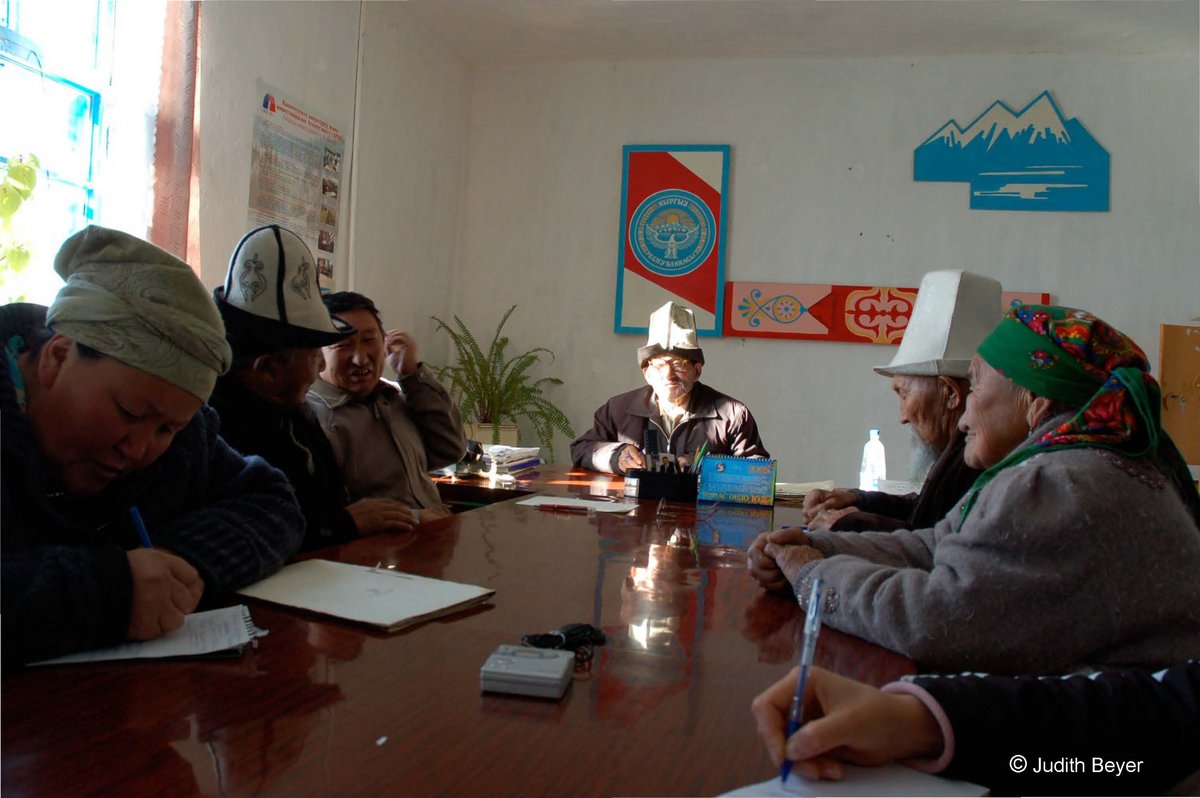Tracing legal connections. Comparing interactional patterns between courts of elders and state courts across Northern Kyrgyzstan
Collaboration with Natalia Alenkina (Law Faculty, American University in Central Asia, Bishkek, Kyrgyzstan) in the frame of a joint CARTI-Fellowship of the Open Society Foundations (2012-2014).

Aim of Project
The project is a legal anthropological investigation of the interaction between courts of elders (aksakal courts) and state courts in contemporary Kyrgyzstan. It aims at a comparison of the work of several aksakal courts in Talas province and Chui province with a strong focus on how the aksakal judges relate to and interact with state judges.
Background
In 1993, two years after the break-up of the Soviet Union, the first president of the now independent Central Asian country Kyrgyzstan, Askar Akaev, set up the courts of elders (aksakal courts, see Constitution of the Kyrgyz Republic 1993, art. 79). The institution was established by presidential decree throughout the country by 1995, but was put into practice first in the countryside, where the authority of the elders (Kyrg. sing. aksakal, lit. whitebeard) and the force of customary law (salt) were widely thought to be unbroken (see Beyer 2005, 2006, 2010 for details).
The newly appointed aksakals were mostly men over the age of sixty who already occupied several roles within the local context: they were heads of households, elders of their lineages, and had served in high positions in the Soviet kolkhoz (collective farms). They had thus acquired different types of knowledge, and the role of mediator in dispute cases was not new to them. However, since their new role in the aksakal courts formally established them as judges, they initially voiced concerns over their lack of “proper” legal knowledge. They also complained about a lack of interest on the part of state officials and state judges in their new work. After having realized that ‘the state’ mostly transferred those cases to them that were considered ‘minor’ (such as theft of animals, land and water disputes, domestic violence, and the division of property in the frame of divorces), they eventually began to ‘customize’ (Beyer under review) the institution in a way that emphasized its ‘ancient’ character. The dispute management occurring within the village aksakal courts is nowadays increasingly perceived as being ‘according to customary law’ (salt boiuncha), even though images of the state, state law, and state judges play a key role in the way the courts are set up and operate (Beyer 2013).
Arenas of interaction
There are several arenas in which state judges and aksakal judges interact with one another: one is on a procedural level, for example when cases are being transferred from one type of court to the other or when cases considered in aksakal courts get appealed in state courts. Another kind of interaction is on an organizational level, particularly in the form of training seminars that are being given by state judges for aksakal court members. In the capital Bishkek these trainings are organized and paid for by the TOS (Russ. territorial’noe obshchestvennoe samoupravlenie). In Talas province, seminars organized by UNIFEM featured presentations of state judges of the city courts who were invited to discuss cases with aksakal court judges. There are also provisions in the law on the aksakal courts (2002), for example art. 35, which state that at least once a year the aksakal judges must report to state judges. While in Bishkek this is adhered to, in Talas, this has not happened once in the two courts studied by Beyer since 2004. While the procedural and organizational aspects of interaction between courts of elders and state courts happen rarely or not at all, both groups nevertheless have very strong opinions about each other.
Findings
The way aksakals organize their court sessions is a mix of what state law prescribes, what state judges or other officials have told them to do and what they think is best in a particular situation. Even though the aksakals have had little contact with state officials, let alone state judges, in the last years, they asked for written statements from the claimants, for documents and certificates, wrote minutes of their decisions and emphasized their position as ‘judge’ by, for example, casually mentioning that usually all attendants at court were supposed to get up from their seats when ‘the judge’ entered the room. As a result, sometimes cases are extensively documented and written down, especially if they were initiated with the police, but also when the elders want to make an impression on a disputing party by forcing him or her to write down their complaints. Sometimes protocols are written, but mostly what gets written down covers only a small aspect of what was actually going on before the court session, during the court session and after the court session. These documents were mostly written on the assumption that they at some point would be read by state judges in order to check on the work of the aksakals. Thus, they reveal more about how the aksakals want to present themselves ‘to the state’ than about how the aksakal court in fact operates. Particularly sensitive cases (e.g. disputes within families ranging from theft to domestic violence) are often not documented at all.
